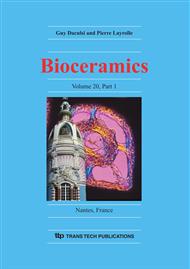p.1025
p.1029
p.1033
p.1039
p.1043
p.1047
p.1051
p.1055
p.1059
Influence of Phase Composition on Degradation and Resorption of Biphasic Calcium Phosphate Ceramics
Abstract:
In this study the degradation behaviour of pure hydroxyapatite (HA), pure tricalcium phosphate (β-TCP) and four biphasic calcium phosphate ceramics was studied to gain information about the influence of the phase composition on this property with the aim to tailor individually adapted bone substitute materials. The chemical dissolution of each ceramic composition was measured by its release of calcium ions into a buffered solution. With decreasing HA content in the ceramics the degradation rate increased. Cell experiments were carried out with stimulated osteoclast-like RAW 264.7 cells. Using biochemical, genetic and microscopic analysis, the differentiation of the cells on the ceramic samples was studied. The monocytic precursor cells differentiated into osteoclast-like cells on all ceramics. The strongest cell differentiation into osteoclast-like cells was found on ceramics with HA/β-TCP ratios of 80/20, 60/40 and 40/60. Cells on these ceramics had many nuclei and the largest cell size. As a result of resorption, lacunas were found on all ceramics except β-TCP. All these experimental results proved the influence of the phase composition on degradation and resorption of calcium phosphate ceramics. Biphasic calcium phosphate ceramics with HA/β-TCP ratios of 80/20 and 60/40 exhibited the most promising properties to serve as synthetic bone substitute materials because for integration in the physiological bone remodeling process the implanted bone substitute materials should have optimized dissolution and resorption properties.
Info:
Periodical:
Pages:
1043-1046
Citation:
Online since:
November 2007
Authors:
Price:
Сopyright:
© 2008 Trans Tech Publications Ltd. All Rights Reserved
Share:
Citation:


